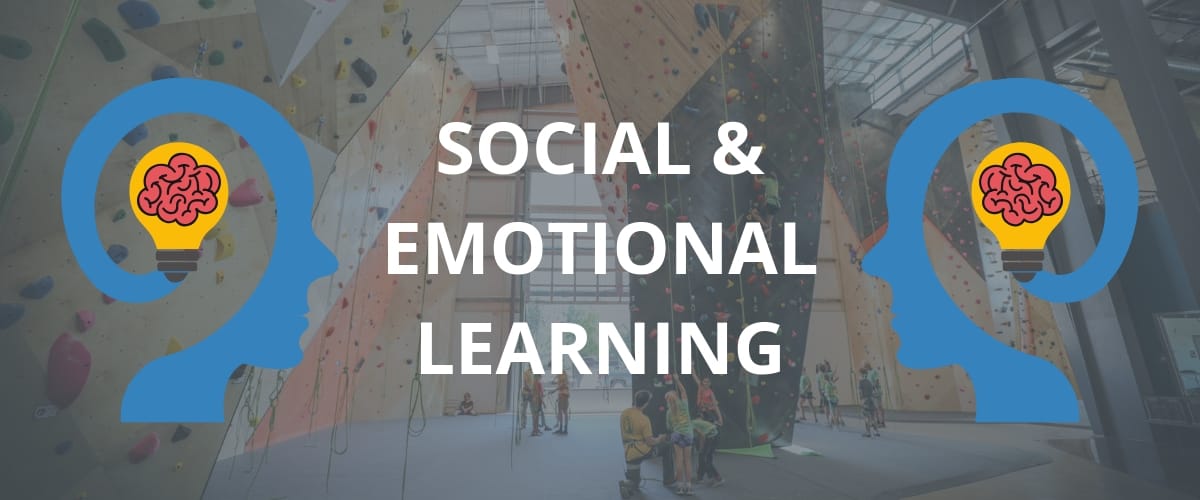Meeting Social & Emotional Learning Goals Using Climbing

Social and emotional learning (SEL) has become a hot topic among youth workers of all stripes. The core competencies of SEL, as identified by CASEL, have positive implications on young people’s lives: “improved classroom behavior, an increased ability to manage stress and depression, and better attitudes about themselves, others, and school” (CASEL 2018). When working with young climbers, the more we can seamlessly support their development and the framework other social support networks use, the better for our programs.
Benefits in using the core competencies of SEL learning for our young climbers go beyond the obvious benefits to their life listed above. These 5 competencies also provide a clear, measurable way to define the emotional competencies related to performing at a high level, while supporting pro-social development.
Youth climbing programs have traditionally assumed that the social and emotional skills associated with climbing will develop as we support young climber’s technical development. Rather than depending on these skills to develop as a corollary to developing the physical skills associated with climbing, it is important to identify and explicitly train these skills so our climbers can succeed in life and on the wall.
We will briefly share the 5 core competencies and the relevant actions to climbing, why they are a benefit to young climbers, and how we as coaches and climbing program staff can support their development. These foci and the associated activities or practices can be addressed in sequence, or as single lessons to address team growth areas.
SEL Competency: Self-Awareness
Description: Self-awareness is a key component of focus and improvement. The ability to self-identify one’s own assets and growth areas and take on a growth mindset about one’s deficits is the foundation for any improvement in climbing. This attitude translates into the ability to identify and improve technical weakness (i.e. poor footwork or inability to use slopers well) and also allows your young climbers to help each other improve by making positive self-reflection and improvement part of your team’s culture.
Activity: Spend one practice where all climbers climb the same three routes: one you identify as pumpy (physically demanding), one that is beta-intensive (technically challenging), and one that has a challenging crux that the coaches point out (mentally intimidating). Once all climbers have climbed all three, have them self-divide based on which of those they identify as their largest area of growth – physical, technical, or mental. These groups will then create a training plan of action to address that deficit.
SEL Competency: Self-Management
Description: Self-management is the next natural focus for a young climber, as it is about self-control, setting goals (and sticking to them), and managing stress. These skills are essential for young, developing climbers to perform.
Activity: Devote time to practice focusing and positive self-talk. While this may seem like an unnecessary distraction during limited practice time, until this sort of stress management is identified and practiced, it will be a challenge to develop. While starting a practice, have all climbers come together and practice breath counting: silently breath in for 3 seconds, hold the breath for 3 seconds, and breath out for 4 seconds. Practice this for 5 cycles. Then, set aside one climb during each practice where climbers must pause as they are cruxing, and count their breath for two cycles and relax while physically or mentally stressed. Be certain to have one-on-one check-ins with climbers and address this practice.
SEL Competencies: Social Awareness and Relationship Skills
Description: While the last two foci were individual skills, Social Awareness as a goal allows you to focus on the dynamics in your team. This SEL competency is best trained in tandem with Relationship Skills. Social Awareness is the ability to take on another party's perspective, and Relationship Skills focus on communication and teamwork. These skills are necessary to develop if your climbers are expected to productively support each other in training and competition.
Activity: There is no better practice for teamwork, communication, and empathy than practicing falls. With young climbers who are lead belaying each other, this is a relatively easy practice. For those who are only being belayed by coaches, be certain that this is done where the climbers can witness each other’s falls. The distance is unimportant to the activity; the important part of the activity as SEL competency development is processing. Following the practice falls, the group should be brought together, and the experience should be processed using the following model: What did we have you do (climber, belayer, and larger team)? Why did we do it? How did it feel? Once climbers share their individual experience, use this as a jumping-off point to discuss strategies for managing fear that they can share with the larger group.
SEL Competencies: Responsible Decision-Making
Description: Responsible Decision-making means many things, however, here we will focus on the ability to identify and solve individual problems. In the context of a climbing team, the best approach to training this skill is to have young climbers practice reading and executing beta.
Activity: Have climbers approach a route at their onsight maximum. With a partner, have the climber walk through their proposed beta for the route. The climber will then – with the reminder of their partner – attempt the route with that specific beta. When they fall, they will be lowered, and propose new beta, repeating until success, or until the coach has instructed climbers and belayers to switch roles. Once both partners have participated in the process, allow time for review. Specifically encourage the climbers to focus on what moves they correctly identified and how.
Takeaways
The SEL competencies are relevant to all areas of young climbers’ lives and using the SEL model allows them to identify what they need to improve on mentally and emotionally. Identifying the competencies brings relevance to their climbing, allows them to practice transferable life skills, and gives clear and identifiable targets for the emotional skills associated with successful young climbers. It is a model they will encounter elsewhere, so it draws their social development into their passion – climbing – and makes climbing relevant in their everyday life.
In the end, naming these skills – so climbers can identify what they are working on – and building time for reflection on them into practice – so climbers can gauge their improvement – are the two most important steps you can take to allowing climbers to develop their SEL competencies.
About The Author

The Headwall Group distills the lessons learned as educators and leaders working in dynamic and high risk environments and brings them to youth-serving organizations. The Headwall group provides trainings, consultation, and curriculum development services that are rooted in our experience as outdoor experiential educators for climbing gyms, summer camps, and schools.
The Headwall Group was founded by Bix Firer and Pat Brehm. Bix Firer (MA, University of Chicago) is currently the Director of Outdoor Programs at College of Idaho and has worked as a wilderness educator, trainer, facilitator, and experiential educator for over a decade. Pat Brehm works as a professional organizational trainer and has spent his career as a climbing coach, facilitator, and outdoor educator.
